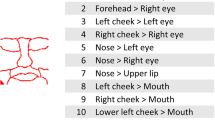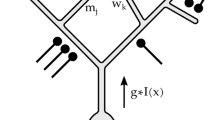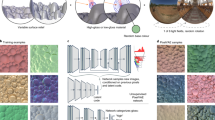Abstract
It is not known how the visual system is organized to extract information about shape from the continuous gradations of light and dark found on shaded surfaces of three-dimensional objects1,2. To investigate this question3,4, we used a learning algorithm to construct a neural network model which determines surface curvatures from images of simple geometrical surfaces. The receptive fields developed by units in the network were surprisingly similar to the actual receptive fields of neurons observed in the visual cortex5,6 which are commonly believed to be 'edge' or 'bar' detectors, but have never previously been associated with shading. Thus, our study illustrates the difficulty of trying to deduce neuronal function solely from determination of their receptive fields. It is also important to consider the connections a neuron makes with other neurons in subsequent stages of processing, which we call its 'projective field'.
This is a preview of subscription content, access via your institution
Access options
Subscribe to this journal
Receive 51 print issues and online access
$199.00 per year
only $3.90 per issue
Buy this article
- Purchase on Springer Link
- Instant access to full article PDF
Prices may be subject to local taxes which are calculated during checkout
Similar content being viewed by others
References
Ramachandran, V. S. Nature 331, 163–166 (1988).
Mingolla, E. & Todd, J. T. Biol. Cyber. 53, 137–151 (1986).
Ikeuchi, K. & Horn, B. K. P. Art. Intell. 17, 141–184 (1981).
Pentland, A. P. IEEE Transactions on Pattern Analysis and Machine Intelligence 6, 170–187 (1984).
Hubel, D. H. & Wiesel, T. N. J. Physiol., Lond. 160, 106–154 (1962).
Hubel, D. H. & Wiesel, T. N. J. Neurophysiol. 28, 229–289 (1965).
Rumelhart, D. E., Hinton, G. E. & Williams, R. J. in Parallel Distributed Processing: Explorations in the Microstructure of Cognition. Vol. 1 (eds Rumelhart, D. E. & McClelland, J. L.) 318–362 (MIT Press, Cambridge, 1986).
Mullikan, W. H., Jones, J. P. & Palmer, L. A. J. Neurophysiol. 52, 372–387 (1984).
Author information
Authors and Affiliations
Rights and permissions
About this article
Cite this article
Lehky, S., Sejnowski, T. Network model of shape-from-shading: neural function arises from both receptive and projective fields. Nature 333, 452–454 (1988). https://doi.org/10.1038/333452a0
Received:
Accepted:
Issue Date:
DOI: https://doi.org/10.1038/333452a0
This article is cited by
-
Face neurons and super-normal stimuli: A window into visual processing
Journal of Biosciences (2022)
-
Neural Mechanisms That Hide Individual Behavioral Differences: Evidence from Psychophysics and Neuroscience
Computational Brain & Behavior (2020)
-
Hippocampal place cells are topographically organized, but physical space has nothing to do with it
Brain Structure and Function (2019)
-
Bayesian cognitive science, predictive brains, and the nativism debate
Synthese (2018)
-
A New RBF Reflection Model for Shape from Shading
3D Research (2017)
Comments
By submitting a comment you agree to abide by our Terms and Community Guidelines. If you find something abusive or that does not comply with our terms or guidelines please flag it as inappropriate.



